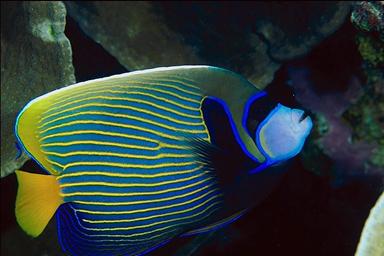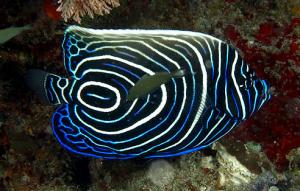Emperor Angelfish

Adult Emperor Angelfish
Emperor angelfish (Pomacanthus imperator) are from the Red Sea and the Pacific and Indian Oceans.
In their natural environment, emperor angelfish are typically found within shallow coral reefs and are sometimes seen in groups. However, you should keep only one emperor angelfish in the aquarium. It doesn't get along with members of its own species in the small confines of the aquarium. It can sometimes be agressive toward smaller fish of other species and will sometimes eat the inhabitants of coral reefs.
Young fish look very different from the adults. The photo above is of an adult fish and the photo below is of a juvenile emperor angelfish. Young emperor angelfish are generally black and have concentric white and blue rings on their bodies. In fact, the young fish really bear no resemblance to the appearance of the adults, except for their body shape. Both the adults and the juveniles are strikingly beautiful.

Juvenile Emperor Angelfish
Juveniles that are raised in captivity don't grow up to be as vividly colored adults as those juveniles that grow to adulthood in their natural environment. This is thought to be due to an inadequate diet in captivity. Unfortunately, there is a lot we don't know about how to provide for many reef fish, such as emperor angelfish. People are often reluctant to keep these fish in reef tanks because they don't want them to eat the inhabitants, but if this is the environment they are found in, then perhaps we should be keeping them in an environment most similar to that in which they are normally found.
They are very sensitive to water conditions and so you'll need to make sure your water quality is nearly perfect. Due to their sensitiveness to poor water conditions, this is not a fish for a beginning saltwater aquarist.
They will generally eat frozen meaty foods, such as crustaceans and marine algae. You can find prepared marine angelfish foods that include sponges and you should include these preparations into it's diet. The more varied their diet, the better. You should also provide live rock for them.
They reach a size of about 15 inches or 38 cm and so you'll need a large tank to house them.
Prices range from around 60 to 150 dollars.
